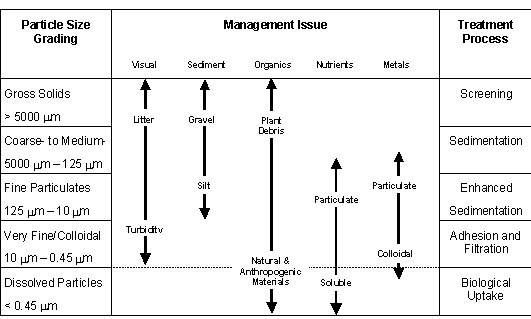Physical Layout of Treatment Measures
The main considerations in assembling the stormwater treatment train are:-
- Determining pollutant characteristics
- Identifying appropriate treatment processes
- Selecting the appropriate treatment sequence
- Evaluating the site constraints
Figure 1 shows the various management issues associated with the pollutant characteristics and corresponding appropriate treatment processes as depicted by Breen (1999).
Figure 1 Stormwater pollutant management issues and appropriate treatment processes (Breen, 1999).
It should be noted from examination of Figures 1 and the figure shown in Introduction to Treatment Strategies that:
- Stormwater treatment requirements need to match the limitations of treatment processes
- Target pollutants have a large size range
- Different treatment processes operate in different particle size ranges
- Different treatment processes operate over different time and hydraulic load
Treatment sequence
The appropriate treatment sequence in managing urban stormwater should commence with the removal of gross pollutants, then progress downstream to coarse material, and finally address fine and soluble contaminants. The space requirements are influenced by the operating hydraulic loading range of the selected treatment measure (see Introduction to Treatment Strategies), which ranges from 1,000,000 m/yr for gross pollutant traps to 10,000 m/yr for swales and ponds to as little as 10 m/yr for bioretention systems.
Most common problems in the unsustainable operation of stormwater treatment measures stem from the misconception that one treatment measure can effectively treat the full range of pollutant types.
As the operating hydraulic loading range of a treatment measures decreases, there is a need for either:-
- more area for treatment (for example a wetland will take up more room than a GPT)
- more strategic placement of treatment measures
- location nearer to source
- several measures distributed throughout the catchment.
There is, however, an optimum hydraulic loading below which many treatment measures will have a reducing benefit/cost ratio.
Treatment effectiveness of many measures:
- decreases with increasing inflow rates
- increases with increasing inflow pollutant concentration
- pre-treatment improves the treatment effectiveness of most facilities (a wetland, for example, should have some form of gross pollutant treatment upstream).
Hydrologic Control
Most treatment measures require some form of hydrologic control to operate in the optimal hydraulic load range. This will involve:
- flow diversion
- flow attenuation and regulation
- isolation or separation of runoff from different sources, eg. infiltration of roof runoff.
